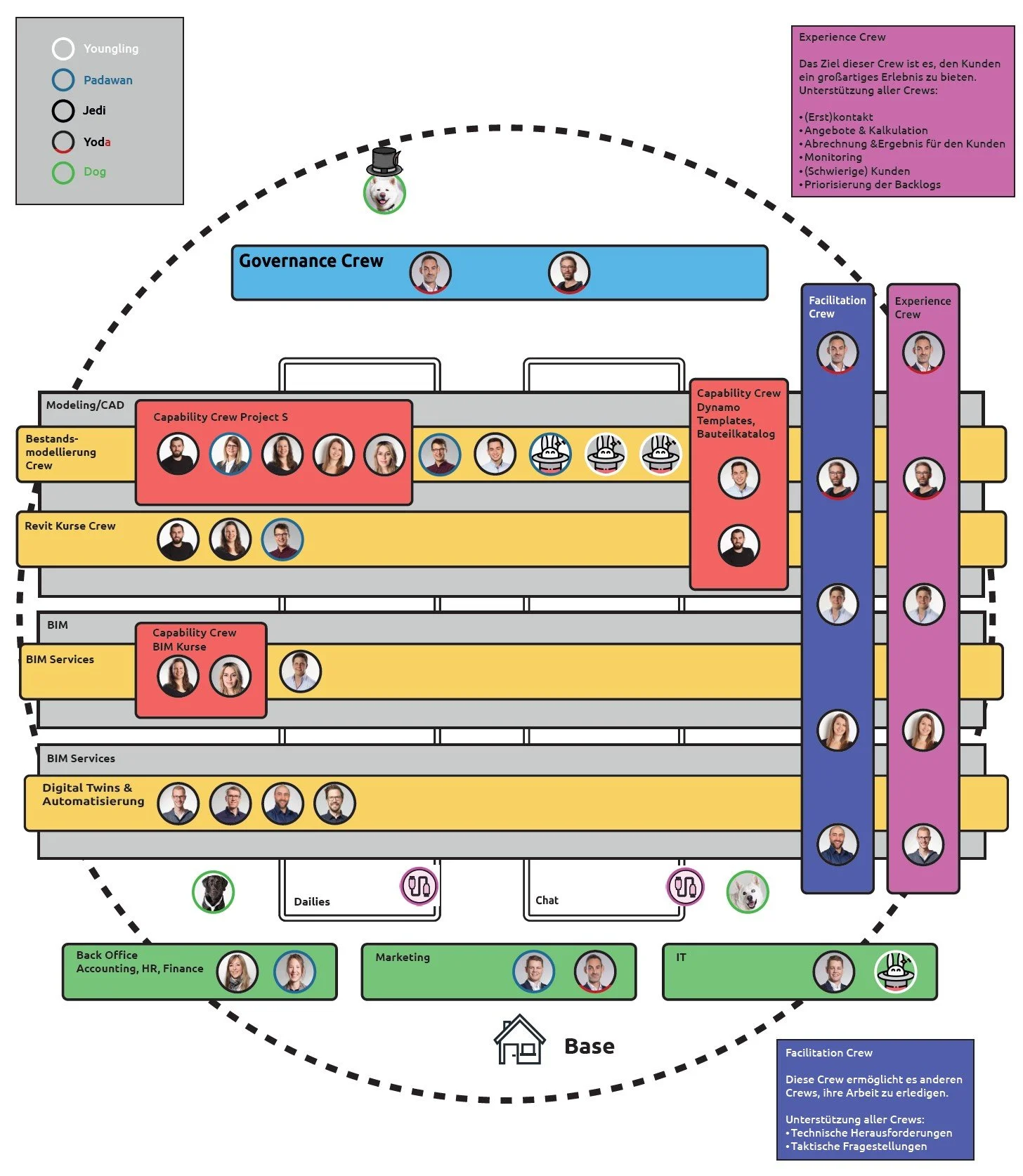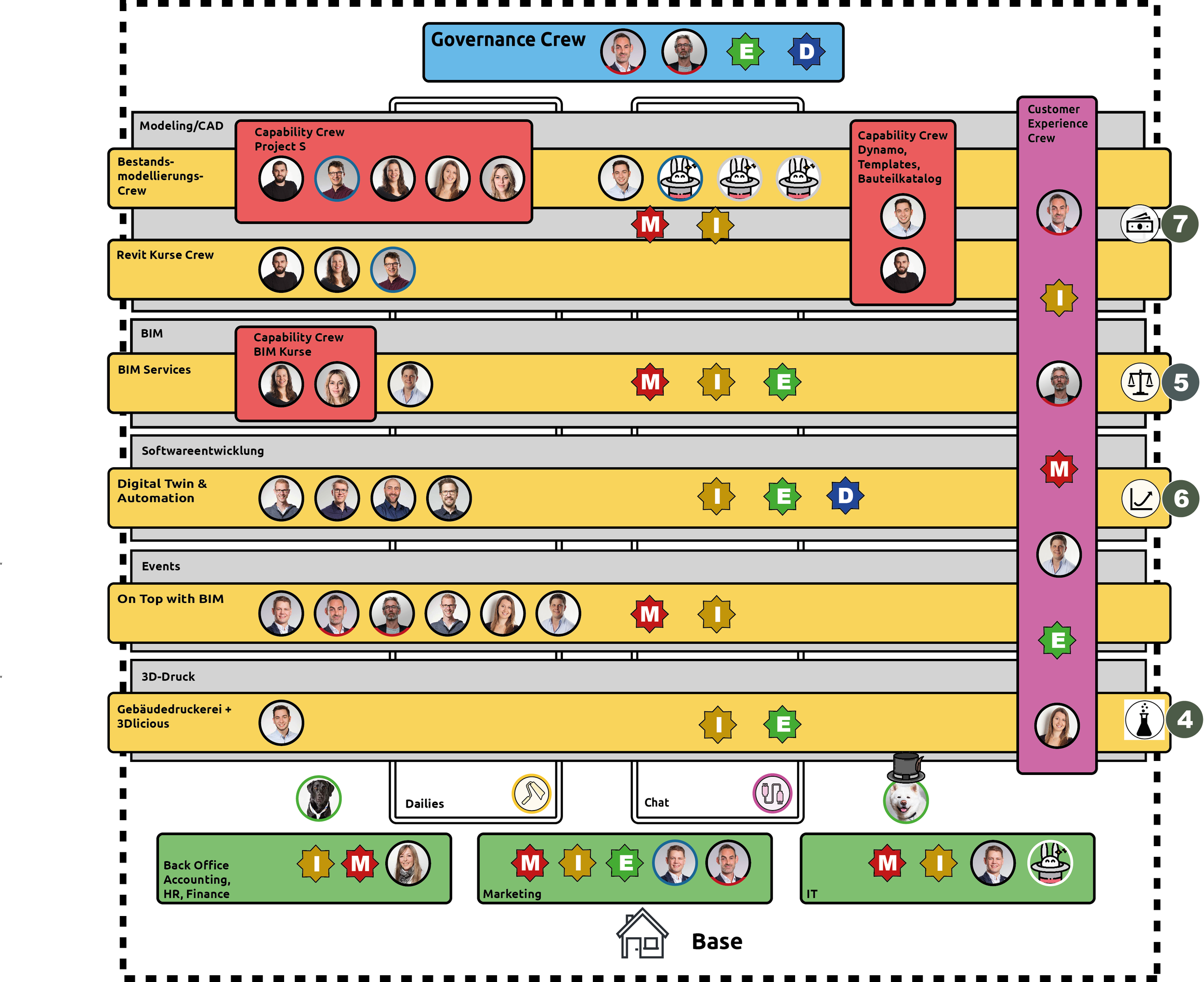Who let the dogs out?
Author: Jan-Paul Ouwerkerk
When your dogs are in your org chart you know you are having fun at work and you are a genuine “corporate rebel”. After reading this case study you will see what I'm talking about!
unFIX is getting more and more spread over the globe. It doesn't matter: big or small companies are finding the benefits of the simplicity and richness of the model! (and don't forget the colorfulness!)
The start of Buildinformed
When Jakob Hirn and Olaf Hermann were working together in quite a big “Corporate” company they tried pioneering “agile ways of workings”. They pitched a multidisciplinary “BIM” team (Building Information Modelling) to the CEO and within their later formed teams they experimented with Scrum and the like. But working together with 750 other engineers spread over different countries and using quite some digital tools was quite challenging. After a few years, they concluded that if only their teams were working “agile” it didn't make any sense. All the other departments and teams were still quite siloed. So their drive to work in a different way sparked a new adventure: Why not start for ourselves and build something from the ground up? That's when Buildinformed was founded in 2015. At the same time, Peter Hirn came on board, Jakob's brother, who first built up call centers on the software side. The idea was to think Integral Planning a bit further and to add software development to it.
They didn't make it easy for themselves, they came up with a challenging purpose: dramatically lowering the CO2 footprint of the design and planning process (and ultimately the building process itself). They started with a total of three people at first, but that “escalated quickly” to ten people and later even 30! (after a harsh dip to fifteen people during Corona they are now with 25 people again).
“We want to end waste in real estate”
| We practice contemporary management… | ... and use the potential of outstanding personalities... | ...to address some of society's biggest wastes of resources. | We research and develop new ways to use and share information from structures. | We make our knowledge and developments available to as many people as possible. | We automate planning and manufacturing processes to minimize the wastage of creative potential. |
For me, this screams innovation and a place for smart free-fought people… But because of their success and (maybe too) rapid growth Jakob and Olaf were struggling with how to manage this… they hired scrum masters and PO’s, but this resulted in a (too) heavy management practice and this was exactly what they didn't want and left their former employer for. They tried everything... Kanban, Scrum, whiteboards, Trello, Jira… but then, do we need to standardize the way of working? That didn't seem right, all the teams were quite different.
First their “org chart” looked like this:
Figure 1.0 (the old org chart)
This worked for a while but then the team grew to 30 people and needed some more specialization and more described detail. it grew to:
Figure 2.0 (the “bigger” old org chart)
Initial Introduction of unFIX
Then this little thing was posted on Linkedin by Jurgen Appelo:
Figure 3.0 (LinkedIn post by Jurgen Appelo)
With some good memories of management 3.0 practices it triggered Jakob to dive in and study unFIX and to start playing around with it. After making the first sketches with the unFIX crew patterns he showed it to Olaf. Olaf was directly convinced and wanted to proceed with it!
The next step was introducing it to the whole company. A tradition within Buildinformed is to skip the “standard” seasonal celebrations (Christmas, eastern, etc.). They just throw a party for every new season. So in the “Winter 2022” party edition, they did a 4-hour workshop around unFIX. They led out different tables with different patterns, among others there was one for Delegation Levels (see picture below) and one for the org design with the different crew types. There were big printouts of Jakobs his first draft.
Learnings from Team Workshop
The model actually changed a lot after that workshop. First, there were some “management layers” in it. Together with the team's reflections, as founders/owners they learned a lot. It was much clearer what their role (should/could) be. What is expected of them, and even more what is not expected of them! For the (formal) middle managers it was a bit scary at the beginning. They were questioning how they could manage the teams without the formal position. Later they found out that it was actually the other way around. With “management” stepping out of the “value streams” they had more room to maneuver and with the autonomous teams, they could determine their own ways of working while the total structure helped align when needed.
Figure 4.0 (After the workshop)
Enhancing the model
This January they added some patterns, mainly the Investment Horizons and the Lifecycle Stages. Of course, the results were nice, but the discussions they had to come to these results were the most valuable. They had new insights and began to understand each other much better. That really helped to align the different teams.
At this stage they have 6 Value Stream Crews pointed at the different services they offer. A Customer/Experience Crew makes sure the customers are happy and enjoy the different products altogether. There are three Capability Crews with expert knowledge in different areas. Besides that, there are 3 Platform Crews who deliver special services to the internal value stream crews. With the two Forums, they make sure that knowledge is shared between all the people and crews. To top it off there is a Governance crew with the two founders/owners.
Figure 5.0 (The latest org picture)
Great learnings
One of their learnings was that they taught that being in the governance crew, they were not supposed to be in any other crew… They later found out that this was actually not a problem. It is important to be aware of what role you are representing at one moment in a different crew and talk about this with the team. Another funny thing to mention is that one of the new hires found the newly learned management language so cool that she created a Confluence page for the next hires to learn more about it even more quicker! That is now a standard part of the onboarding.
For Buildinfromed, learning unFIX was already very easy by all the materials out there. The website is easy to navigate and very colorful. Al the other frameworks look dull in comparison with unFIX!
And if you look closely at the picture you can see that the two dogs owned by the employees of Buildinformed are proudly featured! And besides that, they come up with their own pattern: experience circles around their pictures. Inspired by Star Wars in the legenda you can read that they start at the “Youngling” level, followed by Padawan, Jedi, Yoda, and mastered by Dog ;).
Future Plans
They have big plans for the future, to become a global scale-up service in their business field. And they really think that unFIX will help them grow in that endeavor!
For example, they need to introduce 24x7 support. They already decided that this will not be a separate team, but that support is part of the value stream. Having this in mind, they already told their new product owner for the value stream crew for “digital twins” that the crews have end-to-end responsibility. They should not only focus on requirement engineering and development but also have in mind that their crew needs to deal with the support and maintenance later.
Summary
The unFIX model provides several advantages for Buildinformed. Even with a flexible organization setup and mindset from the beginning, unFIX helps Buildinformed reflect and improve their way of working. It was easy to introduce to the whole company and led to clearer roles and expectations for the founders, their middle managers, and their autonomous teams. The model's flexibility also allowed founders to be part of different crews, so they could use their strengths and expertise where needed.
Using unFIX to model the organization setup helps the teams to form value stream crews to focus on the end-to-end responsibility and customer experience.
Buildinformed plans to continue its growth using unFIX and aims to become a global scale-up service, integrating support into the value stream for enhanced end-to-end responsibilities.
We will definitely have our eyes on Buildinfromed in the coming months and years to see what their next (organizational) developments will be!
===
Many thanks to Olaf Hermann and Jakob Hirn for the time they made available for this case study.







